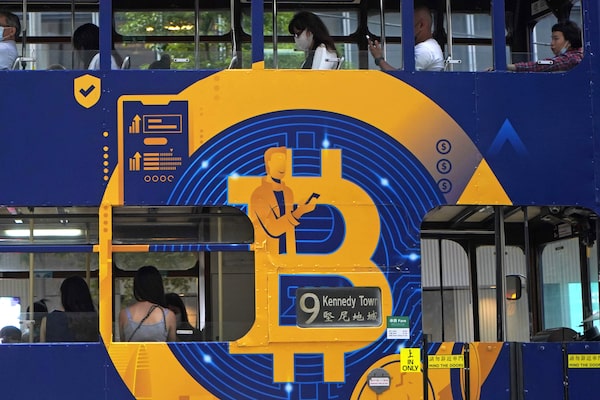
An advertisement for the cryptocurrency Bitcoin displayed on a tram, May 12, 2021, in Hong Kong.Kin Cheung/The Associated Press
In March, bitcoin hit an historic high, reaching a price of more than US$73,000. Its skyrocketing value and increasing popularity attracted many budding investors interested in getting into cryptocurrency. But unless those new investors have tens of thousands of dollars available, it’s likely they’d only buy a fraction of a bitcoin, which is available to buy through a cryptocurrency exchange or some online stock services.
Thanks to its now-exorbitant price, purchasing and owning fractions of one bitcoin is becoming the norm, just as the global supply of available bitcoin has almost reached its limit.
On April 20, bitcoin investors and crypto companies were gearing up for what’s called the halving, an event that happens every four years that could have potential ripple effects across the industry. But what is the halving event, and what actually happened? Here’s what to know:
What is bitcoin halving?
Bitcoin halving is designed to consistently reduce the rate at which new coins are introduced. Bitcoin’s maximum supply of tokens is capped at 21 million, and more than 19 million are already in circulation, which means the supply is quickly reaching its limit.
By halving the amount of coins that enter circulation at a time, the goal is to never reach the 21 million limit – or at least slow it down.
How do you mine a bitcoin, and what does it have to do with the halving?
To extract a bitcoin from the blockchain, which is essentially a public ledger that tracks cryptocurrency transactions, miners race against each other to solve complex algorithms. When someone manages to solve that algorithm, they are rewarded with a set number of bitcoins.
The computational power needed to mine a single bitcoin, which is called its hashrate, has been steadily increasing for months. That means the amount of energy required to mine bitcoin is going up, and it’s getting more expensive. Every time bitcoin is halved, it becomes less profitable to mine, which can potentially hurt large mining operations.
Every four years, starting in 2012, the amount of bitcoin distributed when mining is reduced by half. The first bitcoin halving happened on Nov. 28, 2012 – after three subsequent halvings in 2016, 2020 and now April, 2024, miners can extract only 3.125 bitcoins after solving the algorithm. The next halving, in 2028, will reduce this even further to 1.625.
What did investors hope would happen when bitcoin was halved?
Whenever a halving occurred, the price of bitcoin spiked – a year after the May, 2020, bitcoin halving, bitcoin was up more than 545 per cent. Though some said that increase was heightened owing to increased attention during the pandemic.
Analysts and investors hoped that bitcoin’s price would rise once again. The more scarce bitcoin becomes after each halving, they believe, the more valuable it becomes.
In an April 8 report, analysts from cryptocurrency exchange Bitfinex predicted bitcoin’s price would soar about 160 per cent in the 12 to 14 months after this year’s halving, which they said could push bitcoin to a new high of more than US$150,000.
But other analysts believed that the halving was already a factor in bitcoin’s price increase in March – when it hit the mark of US$73,803.25 – and no further increase would happen.
What did it do to the price?
Since the halving on April 20, there hasn’t been a big impact on the price of bitcoin. As of April 24, the price was sitting at around US$64,500.
Analysts say that bitcoin has increasingly been trading like a regular stock, and is now more susceptible to react normally to market forces – such as geopolitical tensions between Israel and Iran – rather than individual traders buying or selling the cryptocurrency.
Even though there hasn’t been an immediate impact, some believe that the halving could be the first step in a potential increase in bitcoin’s price within the next year.
With a report from Reuters.